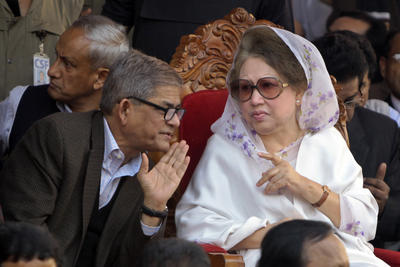In the past decade, GDP growth has commonly exceeded 6 per cent per year and, on many indicators, economic welfare in the country has improved remarkably. There has been a rapid increase in primary school enrolments, outpacing the performance of the rest of South Asia and other low-income countries in recent years. While the average per capita income of Bangladesh’s 155 million people was only US$800 in 2012, there has also been a steady decline in poverty rates.
The poverty headcount ratio fell from 56.6 per cent in 1992 to 48.8 per cent and 31.5 per cent in 2010. The number of poor people declined from nearly 63 million to 47 million in 2010. Despite a young and growing population, the population of poor people declined by 26 per cent over a decade. Poverty reduction was closely linked to the growth in labour incomes and changes in demographics. Labour incomes, both formal and informal, were the main factor behind lower poverty rates.
In particular, the growth of labour-intensive exports has transformed the prospects for the poor in Bangladesh. Despite a sharp check to export growth around the global financial crisis, exports have grown at three to four times the rate of GDP growth, opening up employment opportunities and alleviating extreme poverty. Openness towards trade and investment in the manufacturing sector distinguishes Bangladeshi development strategy, and underpins the country’s notable economic success. Last year again, GDP is estimated to have grown at a healthy, though lower than average, 6 per cent while export growth ran above 18 per cent.
The flip side to the economic success story, of course, is the weaknesses on global public display of Bangladesh’s regulatory infrastructure. When the Rana Plaza clothing factory near Dhaka collapsed last April, killing at least 1100 people, the big Western clothing companies that have their garments manufactured in Bangladesh came under pressure to intervene to improve safety and working conditions in the workshops they buy from. International retailers and fashion brands have begun implementing new monitoring schemes and supporting families affected by the disaster.
Last October, 10 people died when another factory in the Bangladeshi capital, used by big foreign clothes retailers, went up in flames.
Yet, so long as Bangladesh remains Asia’s primary production base outside China for cheap garment manufacture, with exports now running at over US$20 billion a year, there is hope for many millions of Bangladeshi poor.
Bangladesh’s garment exports increased from US$6.8 billion in 2005 to US$19.9 billion in 2012, recording an annual growth rate of 16.6 per cent. During the same period, India’s outward shipments rose from US$8.7 billion to US$13.8 billion, a growth rate of just 6.8 per cent. Bangladesh’s clothing industry is expected to quadruple in size over the next two decades. It already employs 4 million workers, mostly women, in a country with 31 million households. Millions more women are likely to be drawn into the workforce, a positive development in a very conservative society.
Clearly the government has done something right in putting in place the policy settings that opened up this growth potential, even where regulatory neglect is palpable. But looking ahead, dwindling investment interest, anxieties about export growth and lower growth prospects, and much of the blame for a more dismal outlook, can be sheeted home to the state of the Bangladeshi political system.
As Tom Felix Joehnk suggests in this week’s lead, Bangladesh seems so far to have ‘made tremendous progress in recent years — very much despite its appalling leaders’.
While there are problems with the constitutions of a number of democracies in Asia, and how well they allow expression of the will of the people, Bangladesh is now burdened by a system in which neither the ruling Awami League nor the Bangladesh Nationalist Party (BNP) trusts the other to hold a fair election, and probably with good reason. Because the government jettisoned the rules for transition of government, threatening the integrity of last month’s election, the BNP boycotted the election leaving the Awami League in total control.
‘On the world stage’, writes Joehnk, Prime Minister ‘Sheikh Hasina has joined a short list of leaders who have been elected technically but without an electoral mandate. Like the rest, she has silenced critics in the media, captured the courts and ensured that only her supporters are entitled to a fair hearing. Her government has branded the opposition, the BNP and its Islamist allies, as “terrorists”. It would not be fair to pin all the blame on Sheikh Hasina. Opposition leader, Khaleda Zia, chose the road that undid her. While the Western powers and 80 per cent of Bangladesh’s population agreed that Zia should have the fair elections she was demanding, she went further and set the course for deadly street violence and crippling hartals (labour strikes). The BNP is now in disarray and has no better option than to wait out Sheikh Hasina’s new government, hoping they bring about their own downfall’.
The irony is that the BNP would probably have contested the election had it maintained the big lead it held up to a few months ago in the opinion polls. But all that changed as the thuggery of some of its supporters got out of hand.
While it might be too much to expect that pressure from the United States and Europe to hold fresh elections will succeed, hopefully internal pressure to restore the political confidence needed to underpin continuing growth and development somehow might.
Peter Drysdale is Editor of the East Asia Forum.

